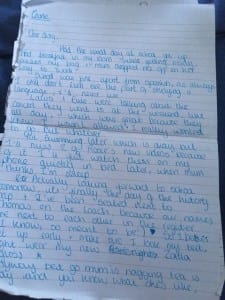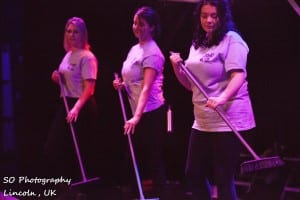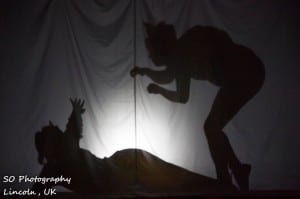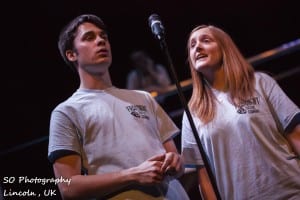In her introduction to Hans Lehmann’s Postdramatic Theatre, Karen Jὓrs –Munby states that Postdramaticism is not about forgetting the dramatic history that preceded it but rather about “subjecting the traditional relationship of theatre to drama to deconstruction” (Lehmann, 2006, 4). In this deconstruction, the preconceived notion that the text is the most important thing and everything else is secondary is challenged along with the Aristotelian dramatic structure. The script and text becomes secondary to the visuals and the creative process and there is a sense of self-awareness from both the actors and the audience that they are partaking/watching a performance.
Within Exit This Way, we adopted this Postdramatic style through adopting a collaborative devising process early on and creating the material as a cast. This is where my role as facilitator came in. Having completed devising material with the cast, I would then take this material to the writers and together we would refine and sort through this material into creating some form of script so that the actors could learn their lines. Below are two examples of when this facilitating was necessary.
Example of Diary Entry for Creation of Charlie’s Character (Turner, 2017)
- Fairy tale – placed a Dictaphone in the middle of the room and asked the cast to, one by one, create a story about a little princess whilst using the theme of debt to mold the story line. This recording was then taken by the creative and edited into the final fairy tale which was seen in the show. The ‘script’ came secondary to the devising process, whereas with a conventional play the script comes first and everything follows that.
- Diary entries – Asked the cast to go away by themselves and write a diary entry as Charlie (eventually became Alice) about things that are happening in her life that might mean she needs to escape. Originally this escape was through a agony aunt persona but this transformed through the process into escaping through novels. The writers then took this material which assisted in them creating character profiles for Charlie/Alice.
I feel like in my role as director I could have placed more faith in my cast to deliver material earlier on in the process. Eventually, as detailed above, we were able to generate some interesting material but this could have been achieved earlier had I placed that faith in the cast to commit.
The Postdramatic element was further explored through the distinction between character and actor. Elinor Fuchs summarizes this with her notion of Death of a Character in which the audience do not invest in the characters as they would in a naturalistic performance. We cemented this through wearing our fragment tops during the sections of the performance when the actors were on stage as themselves. Having the actors sat as themselves throughout the show was a technique that I learnt from Alexander Kelly frequently used by Forced Entertainment which he calls ‘off/on’ in which the audience can see the actors throughout the show so that when the actors become the characters, they were very aware the characters were not ‘real’. We did this in plain sight of the audience with a minimal costume change so that the character was not one that was invested in. The characters wearing their production role tops was an additional reminder to the audience that the cast at the back were themselves not characters.
Three of the cast members in their Fragment tops (Odonnell, 2017)
One instance in the show where the audience could easily becoming engrossed in the story and the world was the fairy tale shadow section. I made sure however that there was an instant snap out of this ‘world’ by the style which the fairy tale narrators said their lines. They went from reading the actual fairy tale in a whimsical, childlike voice to snapping into a direct address with the audience during their lines “This is usually the point in a fairy tale when something magical would happen…” (Fragment Theatre Company, 2017) along with the sheet dropping, thus breaking the audience out of the investment in the character/scene.
Section of the Fairy Tale Shadow Work (Odonnell, 2017)
Rather than showing a polished final product I wanted to highlight the importance of the process in Postdramatic theatre. I thought this could be possible allowing the audience to see the creation of one of our characters in a similar way to how she was created during the process. The character of Laura was created by doing a mind map on a whiteboard +with branches of Laura’s hates, loves, relationships and other obscure information. One by one the cast members added to the various branches until the map was complete (See image below).
I wanted the audience to gain an insight into this creation process rather than showing them the complete character, this also in turn added to the distinction between the actor and the character that she was about to ‘play’. The ‘creation of Laura’ on stage consisted of four of the actors at microphones stating the various facts about Laura, creating a make shift aesthetic and allowing the audience to see into the process of how the character was made.
Creation of Laura Mind Map (Turner, 2017) which was portrayed in the show through cast members at the mic (Odonnell, 2017)
Works Cited:
Lehmann, H,T. (2006) Postdramatic Theatre. Oxon, Routledge.
Odonnell, S. (2017) Three of the Cast Members in their Fragment Tops. Lincoln: SO Photography.
Odonnell, S. (2017) Section of the Fairy Tale Shadow Work. Lincoln: SO Photography.
Odonnell, S. (2017) Cast Members at the Mic. Lincoln: SO Photography.
Turner, J. (2017) Example of Diary Entry for the Creation of Charlie’s Character.
Turner, J. (2017) Creation of Laura Mind Map.




